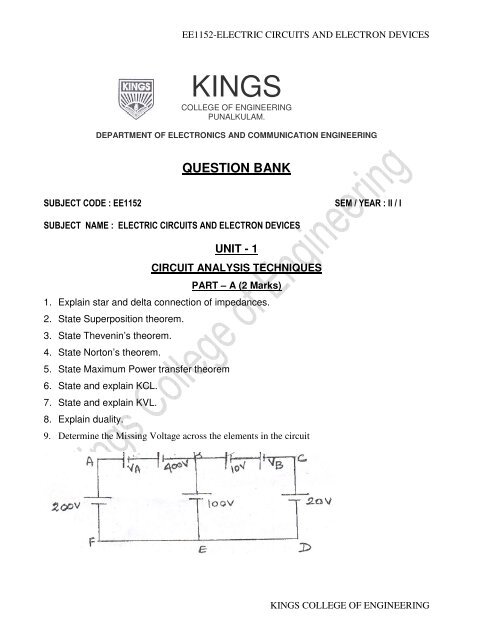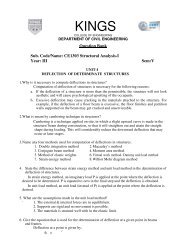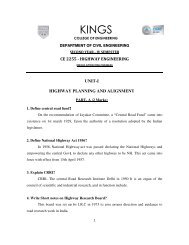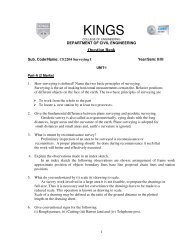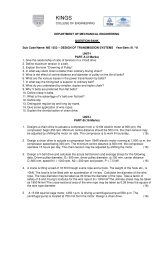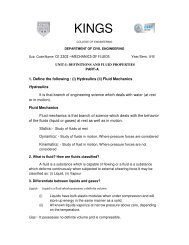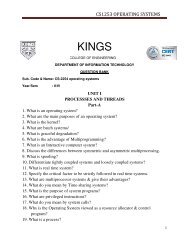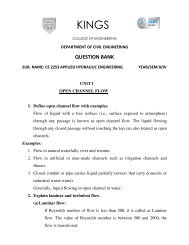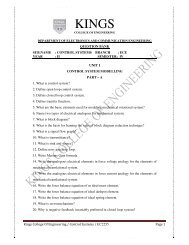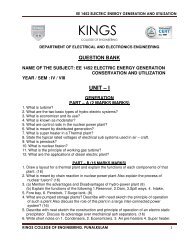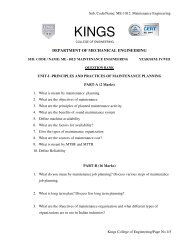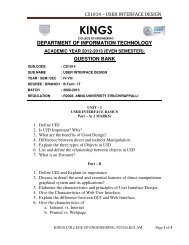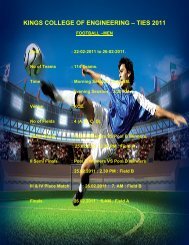ee1152-electric circuits and electron devices - Kings College of ...
ee1152-electric circuits and electron devices - Kings College of ...
ee1152-electric circuits and electron devices - Kings College of ...
You also want an ePaper? Increase the reach of your titles
YUMPU automatically turns print PDFs into web optimized ePapers that Google loves.
EE1152-ELECTRIC CIRCUITS AND ELECTRON DEVICES<br />
KINGS<br />
COLLEGE OF ENGINEERING<br />
PUNALKULAM.<br />
DEPARTMENT OF ELECTRONICS AND COMMUNICATION ENGINEERING<br />
QUESTION BANK<br />
SUBJECT CODE : EE1152<br />
SEM / YEAR : II / I<br />
SUBJECT NAME : ELECTRIC CIRCUITS AND ELECTRON DEVICES<br />
UNIT - 1<br />
CIRCUIT ANALYSIS TECHNIQUES<br />
PART – A (2 Marks)<br />
1. Explain star <strong>and</strong> delta connection <strong>of</strong> impedances.<br />
2. State Superposition theorem.<br />
3. State Thevenin’s theorem.<br />
4. State Norton’s theorem.<br />
5. State Maximum Power transfer theorem<br />
6. State <strong>and</strong> explain KCL.<br />
7. State <strong>and</strong> explain KVL.<br />
8. Explain duality.<br />
9. Determine the Missing Voltage across the elements in the circuit<br />
KINGS COLLEGE OF ENGINEERING
EE1152-ELECTRIC CIRCUITS AND ELECTRON DEVICES<br />
10. Find total Inductance<br />
PART – B (16 Marks)<br />
1. Apply KCL <strong>and</strong> KVL to the circuit shown in fig.<br />
2. Find the current through branch AB by using superposition theorem.<br />
KINGS COLLEGE OF ENGINEERING
EE1152-ELECTRIC CIRCUITS AND ELECTRON DEVICES<br />
3. Find the current through 5 ohm resistance using Superposition theorem.<br />
4. Find the current through 10 ohm resistance using Nortan’s theorem.<br />
KINGS COLLEGE OF ENGINEERING
EE1152-ELECTRIC CIRCUITS AND ELECTRON DEVICES<br />
5. Find the Current (I) in 20Ω Resistance using Thevenin’s theorem<br />
6. Find the resistance between A & B , A & C<br />
KINGS COLLEGE OF ENGINEERING
EE1152-ELECTRIC CIRCUITS AND ELECTRON DEVICES<br />
7. Consider the following network as shown in figure. Determine the power observed by<br />
the 6Ω .<br />
8. Find the total Current <strong>and</strong> total Resistance in the circuit given<br />
KINGS COLLEGE OF ENGINEERING
EE1152-ELECTRIC CIRCUITS AND ELECTRON DEVICES<br />
UNIT – II<br />
TRANSISENT RESPONSE AND RESONANCE IN RLC CIRCUITS<br />
PART – A (2 Marks)<br />
1. What is significance <strong>of</strong> initial conditions?<br />
2. Write a note on initial conditions in basic circuit elements.<br />
3. What is time constant?<br />
4. Write a note on under damped, over damped <strong>and</strong> critically damped systems.<br />
5. Define (i) rise time, (ii) time delay in respect <strong>of</strong> step response <strong>of</strong> second order system.<br />
6. What do you mean by resonance?<br />
7. What is Q-factor?<br />
8. What is anti-resonance?<br />
9. Find the value <strong>of</strong> Q-factor for an Inductor & Capacitor.<br />
PART – B (16 Marks)<br />
1. Derive an expression for step response <strong>of</strong> series R-L circuit.<br />
2. Derive an expression for step response <strong>of</strong> series R-C circuit.<br />
3. Explain about current decay in source free series R-L circuit.<br />
4. In how many seconds after t=o has the current i(t) become one half <strong>of</strong> its initial value<br />
in the given circuit shown in fig.<br />
KINGS COLLEGE OF ENGINEERING
EE1152-ELECTRIC CIRCUITS AND ELECTRON DEVICES<br />
5. Explain the step response <strong>of</strong> RLC circuit.<br />
6. Find the expression for the current in a series RLC circuit fed by a D.C. voltage <strong>of</strong> 20v<br />
with R=8Ω, L=5H, C=1/8F. Assume the initial conditions to be zero.<br />
7. Explain Series Resonance.<br />
8. A series RLC circuit consists <strong>of</strong> R=50Ω, L=0.05H <strong>and</strong> C=0.05µF. Calculate the<br />
frequency <strong>of</strong> resonance. A variable frequency sinusoidal voltage <strong>of</strong> value 50v is<br />
applied to the circuit. Find the frequency at which voltage across L & C is maximum.<br />
Also calculate voltages across L & C at frequency <strong>of</strong> resonance. Find maximum<br />
current in the circuit.<br />
9. Briefly explain the parallel resonance.<br />
10. A resistor & capacitor are in series with a variable inductor. When the circuit is<br />
connected to 200v, 50Hz supply, the maximum current obtained by varying the<br />
inductance is 0.314A. the voltage across capacitor, when the current in the circuit is<br />
maximum is 800v. find the values <strong>of</strong> series circuit elements.<br />
UNIT-III<br />
SEMICONDUCTOR DIODES<br />
PART – A (2 Marks)<br />
1. What is charged particle? Define the unit <strong>of</strong> the charge.<br />
2. What are the applications <strong>of</strong> CRO?<br />
3. What is valance b<strong>and</strong>?<br />
4. What is covalent b<strong>and</strong>?<br />
5. What is forbidden b<strong>and</strong>?<br />
6. Explain semiconductor types?<br />
7. Define energy level <strong>and</strong> energy b<strong>and</strong>.<br />
8. What is Fermi level?<br />
9. What is a semiconductor?<br />
10. What is meant by <strong>electron</strong> –hole pair?<br />
11. What is p-type semiconductor?<br />
12. What is doping?<br />
KINGS COLLEGE OF ENGINEERING
EE1152-ELECTRIC CIRCUITS AND ELECTRON DEVICES<br />
13. What is hole current /<strong>electron</strong> current?<br />
14. Define law <strong>of</strong> mass <strong>of</strong> action<br />
15. What is drift current?<br />
16. What is diffusion current?<br />
17. What is forward <strong>and</strong> reverse resistance <strong>of</strong> a diode?<br />
18. What is cut in voltage <strong>of</strong> a diode?<br />
19. What is switching characteristics <strong>of</strong> diode?<br />
20. What is Zener break down voltage?<br />
21. Give the expression for transition capacitance <strong>of</strong> a diode (C T ).<br />
22. What are applications for zener diode?<br />
PART – B (16 Marks)<br />
1. Explain the theory <strong>of</strong> PN junction <strong>and</strong> explain how it acts as diode?<br />
2. Derive the diode equation <strong>of</strong> the diode<br />
3. Explain <strong>and</strong> derive the current components <strong>and</strong> switching characteristics <strong>of</strong> diode?<br />
4. Derive the expression for transition <strong>and</strong> diffusing capacitance.<br />
5. Explain the Zener diode <strong>and</strong> it’s breakdown mechanism?<br />
1. Define Transistor<br />
2. Define transistor action<br />
3. Define delay time<br />
4. Define rise time <strong>and</strong> fall time.<br />
5. Define turn on <strong>and</strong> turn <strong>of</strong>f time<br />
6. Define power transistors.<br />
UNIT – IV<br />
TRANSISTORS<br />
PART – A (2 Marks)<br />
7. Define current amplification factor in CC transistor.<br />
8. What are the values <strong>of</strong> input resistance in CB, CE & CC configuration?<br />
9. What are the advantages <strong>of</strong> FET?<br />
10. What is a bias? What is the need for biasing?<br />
KINGS COLLEGE OF ENGINEERING
EE1152-ELECTRIC CIRCUITS AND ELECTRON DEVICES<br />
11. What do you underst<strong>and</strong> by DC <strong>and</strong> AC load line?<br />
12. What is meant by operating point Q?<br />
13. What are all the factors that affect the stability <strong>of</strong> the operating point?<br />
14. Define Stability factor S.<br />
15. Why voltage divider bias is commonly used in amplifier <strong>circuits</strong>?<br />
16. How FET is known as voltage variable resistor?<br />
17. How self bias circuit is used as constant current source?<br />
18. What is thermal runaway?<br />
19. Why self-bias technique is not used in enhancement type MOSFET?<br />
20. What are h<strong>and</strong>ling precautions for MOSFET?<br />
21. In which region the JFET act as a simple resistor <strong>and</strong> why?<br />
22. Why FET is called as voltage controlled device?<br />
23. Define the channel width <strong>of</strong> JFET.<br />
24. Define Base spreading resistance.<br />
25. Write the advantages <strong>of</strong> N channel MOSFET over P channel MOSFET<br />
26. Write the characteristics <strong>of</strong> JFET<br />
27. What is pinch <strong>of</strong>f voltage?<br />
PART – B (16 Marks)<br />
1. Explain the transistor action.<br />
2. Explain the operation <strong>of</strong> BJT <strong>and</strong> its types?<br />
3. Write comparisons <strong>of</strong> CC, CE, <strong>and</strong> CB configuration?<br />
4. Explain the breakdown in transistor.<br />
5. Explain the transistor switching times.<br />
6. Explain the operation <strong>of</strong> JFET<br />
7. Derive MOSFET <strong>and</strong> explain its enhancement?<br />
KINGS COLLEGE OF ENGINEERING
EE1152-ELECTRIC CIRCUITS AND ELECTRON DEVICES<br />
UNIT – V<br />
SPECIAL SEMICONDUCTOR DEVICES<br />
PART – A (2 Marks)<br />
1. What is tunnel diode?<br />
2. What is valley voltage <strong>of</strong> tunnel diode?<br />
3. What is varactor diode?<br />
4. What are the applications <strong>of</strong> varactor diode?<br />
5. What are the applications <strong>of</strong> tunnel diode?<br />
6. What are the applications <strong>of</strong> PIN diode?<br />
7. What is photodiode?<br />
8. What is phototransistor?<br />
9. What are photovoltaic sensors?<br />
10. What are the types <strong>of</strong> display <strong>devices</strong>?<br />
11. What are the advantages <strong>of</strong> LED?<br />
12. What is forward break over voltage?<br />
13. Define holding current.<br />
14. Define latching<br />
15. What is the turn OFF mechanism used for SCR?<br />
16. What is forward break over voltage <strong>and</strong> reverse break over voltage?<br />
17. Give the application <strong>of</strong> LASER?<br />
18. What is TRIAC?<br />
19. What is DIAC?<br />
20. What is UJT?<br />
21. What are the different regions in characteristics <strong>of</strong> UJT?<br />
PART – B (16 Marks)<br />
1. Describe the operation <strong>of</strong> zener diode <strong>and</strong> explain its characteristics.<br />
2. Explain the tunneling phenomenon.<br />
3. Write short notes on varactor diode <strong>and</strong> PIN diode.<br />
KINGS COLLEGE OF ENGINEERING
EE1152-ELECTRIC CIRCUITS AND ELECTRON DEVICES<br />
4. Explain the laser action for laser diode.<br />
5. Describe the operation <strong>of</strong> LED <strong>and</strong> LCD.<br />
6. Explain the operation <strong>and</strong> characteristics <strong>of</strong> SCR.<br />
7. Explain the operation <strong>and</strong> characteristics <strong>of</strong> TRIAC.<br />
8. Explain the operation <strong>and</strong> characteristics <strong>of</strong> DIAC.<br />
KINGS COLLEGE OF ENGINEERING


